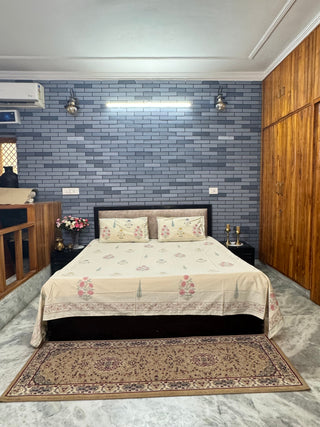Care and Maintenance
Fabric Properties and Wash Care
All Dalore products are crafted from the finest natural fibres, with each piece reflecting the unique touch of skilled artisans. The intricate processes of hand spinning, dyeing, weaving, block printing, and embroidery contribute to the distinctiveness of each product. We use both natural and synthetic dyes to minimise our environmental impact while achieving optimal colour quality. Our bleaching process of certain cloths relies solely on biodegradable hydrogen peroxide.
Please read the instructions given with our product. Dry clean or Hand wash as instructed.
Fabric Care
Maintaining your Dalore India products is usually straightforward. Our superior craftsmanship ensures durability and long lasting. Please refer to the specific guidelines for handwoven Cotton, Silk, and Wool.
Care for Handwoven Cotton
Most of Dalore's apparel and home furnishings are made from 100% pure cotton. Cotton offers enhanced breathability, making it cooler and softer, and more absorbent. Cotton keeps you cooler in summer and warmer in winter. Handwoven cotton also has a unique texture and character. Cotton is a robust fibre, maintaining its strength even when wet, and holds up well to frequent washing.
Shrinkage: During dyeing and printing, the fabric undergoes repeated washing to ensure thorough dye absorption and reduce shrinkage. Depending on care, additional shrinkage ranges from 5-7% for printed fabrics and 7-10% for woven items.
Laundering: Refer to the care label on garment for specific instructions. Cotton is strong when wet, so it’s easy to care for. Regular washing will make the fabric softer and more absorbent. Follow these tips to maintain your garment:
- Machine wash cold on a gentle cycle.
- Wash with similar colours and turn garments inside out, especially dark colours.
- Some colours may need to be washed separately initially.
- Close zippers and hooks to avoid snagging.
- If using bleach, opt for non-chlorine bleach to be gentler on fabrics and the environment.
- Tumble dry on low heat and remove items promptly, preferably while still damp.
Ironing: Iron while the fabric is still damp with a warm to hot iron. Iron on the backside of the cloth. If the item is dry, use a spray bottle to moisten the fabric.
Care for Handwoven Wool
The history of wool spinning and weaving dates back around 9,000 years. It is mostly produced from sheep's fur. Wool’s scaly fibres offer excellent properties such as water resistance, perspiration absorption, and insulation. Wool is highly elastic and the most crease-resistant natural fibre but is less strong than cotton.
Locally sourced wool creates soft, textured fabrics with hand-spun. Hand-spun wool varies in thickness, leading to natural shading from uneven dye absorption. These subtle variations in texture and colour make handwoven wool fabrics unique.
Shrinkage: Wool fibres have tiny scales that can cause felting and shrinkage when wet. To prevent this, wool must be cleaned carefully.
Laundering: Refer to the care label on your garment. Dry cleaning is recommended. If hand washing, avoid agitation to prevent felting. Wool is elastic, so do not stretch the fabric when wet. After dry cleaning, avoid storing wool items in plastic bags to ensure they can breathe.
Ironing: Wool is naturally crease-resistant. To remove wrinkles, press with a damp cloth and use a steam iron or hang the item in steam from a hot shower.
Disclaimer:
- There can be a slight difference in colour and texture of the product as seen in the site as compared to the actuals, as these are handmade and handcrafted products.
- In handwoven products thread pulls are not considered as damage and no return will be allowed for the same unless or otherwise it is a hole in the product.
- The product colour may slightly vary due to photographic lighting sources or your monitor settings.
- In handcrafted products smudges will not be considered as damage.

